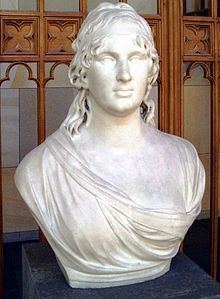Father Johann Elias Enke | Name Wilhelmine, von | |
 | ||
Born 29 December 1753 ( 1753-12-29 ) Died 9 June 1820(1820-06-09) (aged 66) Spouse Johann Friedrich RietzFranz Ignaz Holbein | ||
Wilhelmine von Lichtenau
Wilhelmine, Gräfin von Lichtenau, born as Wilhelmine Enke, also spelled Encke (29 December 1753 in Potsdam – 9 June 1820 in Berlin), was the official mistress of King Frederick William II of Prussia from 1769 until 1797 and was elevated by him into the nobility. She is regarded as politically active and influential in the policy of Prussia during his reign.
Contents
Biography
Her father, Johann Elias Enke, was a chamber musician in service of King Frederick II of Prussia. Wilhelmine met Crown Prince Fredrick William in 1764. The king preferred that the crown prince maintain a relationship with her rather than have changing relationships with foreign women, and in 1769 she became the crown prince's official mistress. The couple had five children, of whom only one survived to adulthood:
In 1782, Fredrick William arranged for her to marry his councillor and chamberlain Johann Friedrich Rietz (1755–1809), but the relationship between Wilhelmine and Fredrick William continued.

It is debated whether Wilhelmine co-operated with Johann Rudolph von Bischoffswerder and Johann Christoph von Wöllner to keep the monarch under control. Wilhelmine was given the title Countess von Lichtenau in 1794, but that was not made public until 1796.
After Frederick William died in 1797, Wilhelmine was exiled and her property confiscated, although she was granted a pension (1800). In 1802 to 1806, she was married to the dramatic Franz Ignaz Holbein, known as "Fontano" and 26 years her junior, in Breslau (now in Poland and renamed Wrocław). In 1811, Napoleon allowed her to return to Berlin.
Legacy
Wilhelmine, known popularly as "Beautiful Wilhelmine", is closely associated with the Marmorpalais in Potsdam. As Friedrich Wilhelm II's official mistress, she had great influence on the interior decoration of the palace. Following plans by Michael Philipp Boumann, an early classicist style townhouse called Lichtenau Palace was erected for her at the edge of Potsdam's Neuer Garten, at a site on today's Behlertstrasse.
During her lifetime, she was the subject of satire, and following fake memoirs, she published her own. She is a main character in Ernst von Salomon's 1965 novel Die schöne Wilhelmine, which also was turned into a 1984 television serial.
